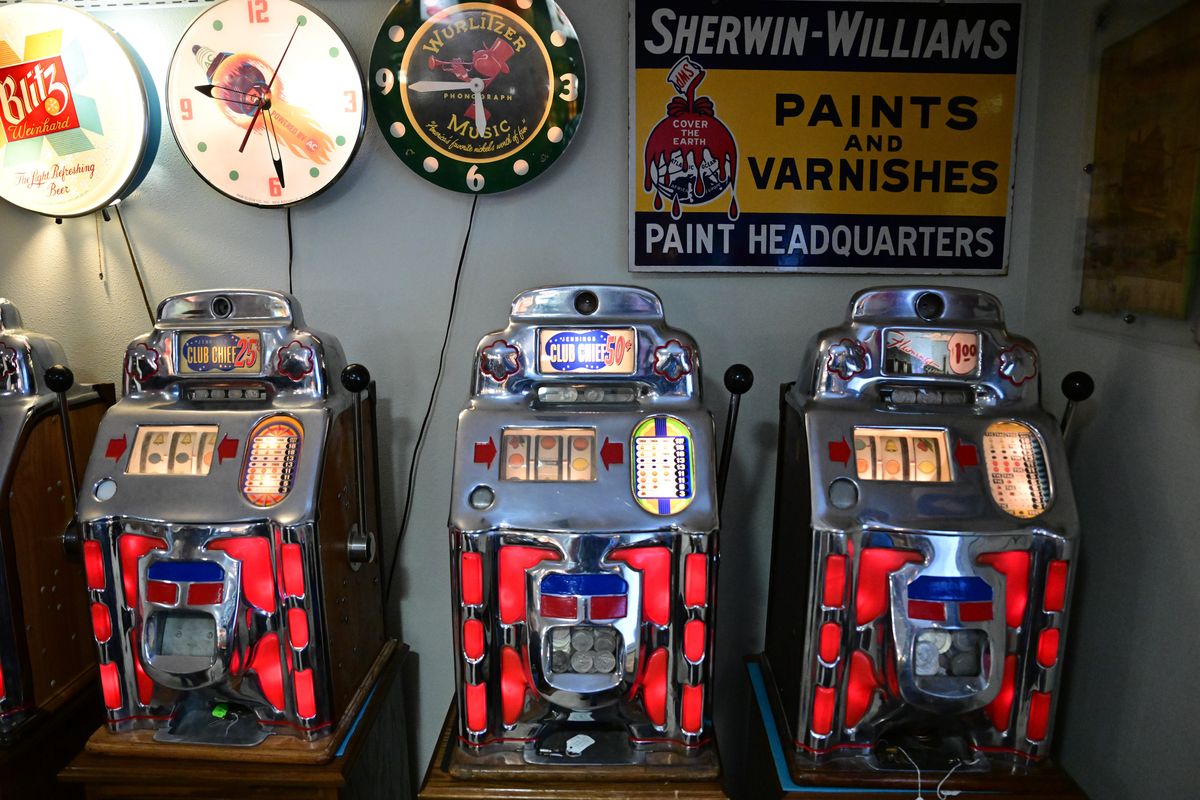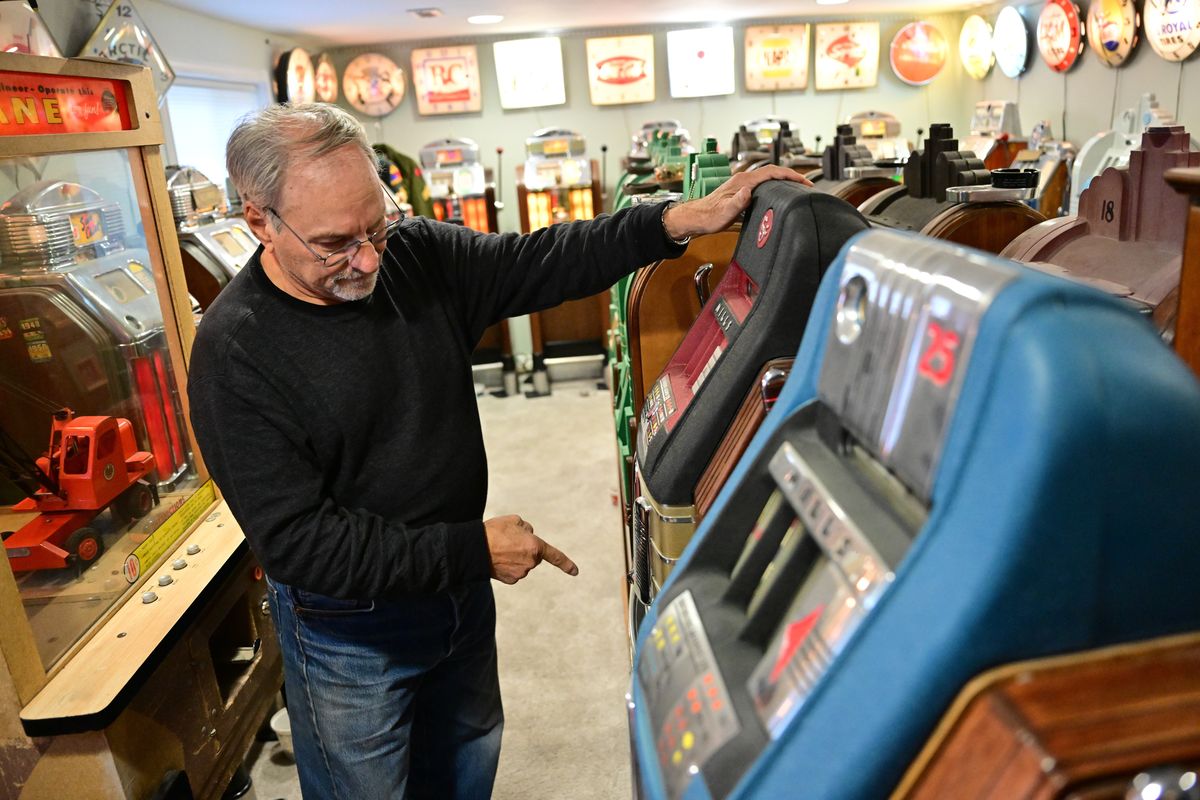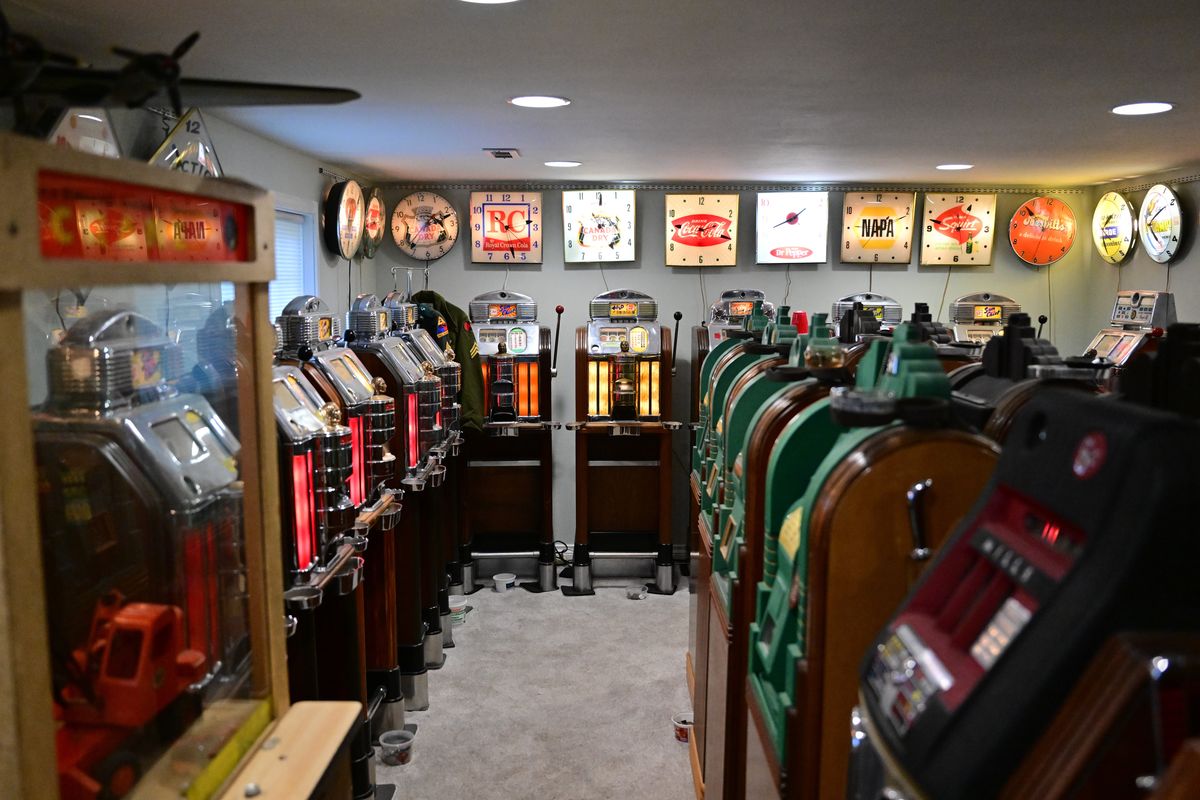The Collector: Terry Burns’ Spokane Valley home lights up with distinctive coin-operated machines
Terry Burns shows off his collection of vintage slot machines on Oct. 24 at his home in Spokane Valley. (Tyler Tjomsland/The Spokesman-Review)
A stroll through Terry and Peggy Burns’ Spokane Valley home evokes nostalgia for a time when you could buy an ice-cold bottle of Coca-Cola for 10 cents, try your luck on a one-armed bandit for a nickel and have your fortune told for a penny.
For more than 30 years, Terry has collected coin-operated pieces of Americana.
“It started shortly after we moved here from Sacramento,” he said. “On my lunch hour, I went to an antique store in Coeur d’Alene and saw a vintage slot machine. I remember seeing those kinds of machines in Reno.”
He bought it in part because the seller told him he lived in Spokane and that if the machine broke, he could call him. Sure enough, the handle jammed a few days later, so Terry took it to the fellow’s house.
“My jaw dropped,” he said. “The guy had (antique) gumball machines, slot machines and jukeboxes! I thought … I have to have some of these!”
Over time, he collected 21 jukeboxes, but when the fellow who kept them running retired, he sold them all.
“When the jukeboxes were gone, the house echoed,” Peggy said. “We had space.”
Not for long.
A rainbow of 1930s-era candy dispensers flanked by a pair of popcorn machines line part of the living room.
“They aren’t poppers,” Terry said of the popcorn machines. “A vendor would come by and fill the machines, and the light kept it warm.”
A Coca-Cola machine in the dining room sells cokes for a dime.
“This is a number 44,” he said. “That’s the number of bottles it holds.”
His coin-op collection focuses on items from the 1920s to 1940s. These machines sold everything from gumballs to postage stamps.
A green and yellow Vendorama offers ballpoint pens for a quarter. Nearby, a tall scale promises to tell you if you’ve gained or lost weight. The Hershey’s candy dispenser next to it was iconic in its time.
“The same machine sold lots of different things,” Terry said. “The most common were combs and condoms.”
Long before video games captured kids’ attention, mechanical games promised fun. Burns has a coin-operated crane that challenged players to scoop dried beans and fill a container. A line of shiny pistols provided tabletop target practice. He even has napkin holders that offered entertainment. For a penny, you could test your IQ with the Quiz Master or have the Swami tell your fortune.
“All of my machines work and are meant to be played,” he said. “My middle name is fun.”
Vintage slot machines, like the one that started it all, make up the bulk of the collection.
“Every machine has a bucket of money and if you win, it goes back into the bucket.”
He uses car references to describe the primary manufacturers of antique slots.
“Mills made more machines than anybody – they’re Chevrolets. Jennings made the second most, they’re Fords and Pace machines are the Chryslers. Watlings are the Rolls-Royce.”
Two shiny gold Watlings have similar names. The 1935 Rol-A-Tor features the famous Watling horn of plenty curving around the top, spilling fruit. Terry said not many of these were produced because a washing machine manufacturer said the name was too similar to their washers.
“So, Watling just changed the “r” to a “p” and made the Rol-A-Top,” he said pointing to the newer version.
His oldest slot machine dates between 1896 and 1906. Its cabinet is solid oak with a cast iron interior, and it has quite a story.
“I got a call from a gentleman who told me that many years ago his family had a bar in Nebraska,” Terry said. “His dad was dying and he wanted to know if I’d be interested.”
Of course, he was.
“This kind of stuff does not show up – especially in the West,” he said.
It turns out the gentleman’s father had a lot more life in him. Several years passed before the beautiful but cumbersome machine arrived in the Burns’ basement.
“We had it a year or two and then the guy called and said his sister really wanted it,” Terry said.
Terry agreed to sell it back to the sister who’d originally declined to take it.
Another year or two passed and again the Burns’ phone rang. The sister was going through a divorce and her mother insisted the heirloom return to Peggy and Terry.
None of the other slots has such a storied past, but they still tell tales. Terry owns Jennings red light-up machines in nickel, dime, quarter and dollar versions.
“Jennings’ theme was Indians,” he said, pointing to the figurehead on a Sun Chief game.
A green Mills model from the late 1930s features a uniformed man on the front, holding a gentleman’s hat, coat and cane. The Page Boy slot takes 50-cent pieces.
Terry often meticulously restores the machines but sometimes leaves them in their well-played condition. His shop holds the overflow.
“We passed collecting and went to hoarding years ago,” he said. “But we collect things we like, not because of their value. Remember what my middle name is.”



